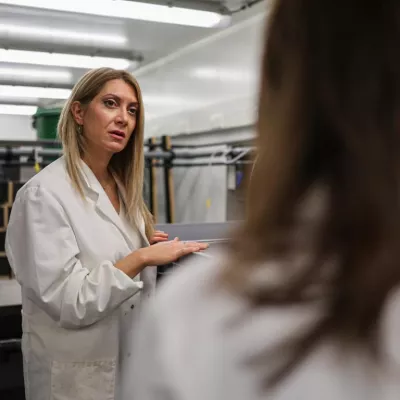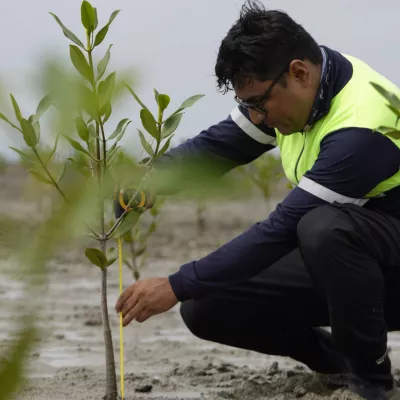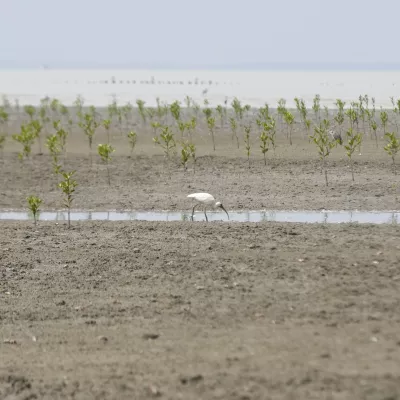Eco-engineering in action: mangroves flourish on artificial island
Mangroves are vital ecosystems: they store carbon, filter water, provide habitat for diverse plant and animal species, and protect coastlines from erosion and flooding. They can also store up to four times more carbon than tropical rainforests. As a result, they make coastal communities more resilient to the effects of climate change. Unfortunately, half of Ecuador’s mangroves have been lost since 1980.
Exceptional mangrove growth
In 2023, the AquaForest project was launched through a collaboration between partners from government, science and industry. AquaForest serves as a blueprint for mangrove restoration that can be applied on a large scale and in different regions worldwide. The 50-hectare island in Ecuador is the first concrete example of this approach.
At the end of last year, 12,000 trees and 10,000 seedlings were planted together with local organisations, followed by another 11,500 seedlings in February 2025. Fundación Calisur, a local expert in mangrove restoration, monitors the growth and health of the mangroves. Measurements show that 90% of the plantings survive, resulting in around 30,000 growing trees.
This is the largest horizontal growth that Fundación Calisur has observed in 16 years. They believe this is due to the optimal conditions offered by the island design. The growth index is more than three times higher than comparable local restoration projects, demonstrating the importance of eco-engineering, a carefully designed ecosystem and multidisciplinary collaboration in nature restoration.
Living lab
The Ecuadorian university ESPOL and the organisation Aves y Conservación closely monitor the biodiversity on the island. So far, 20 bird species have been observed, including the Little Stint and Wilson’s Kentish Plover. Both are classified as Near Threatened by the International Union for the Conservation of Nature (IUCN).
In addition to birds, ESPOL also studies the presence of invertebrates. Based on sampling at various locations, 20 species have already been identified, including molluscs, annelids, echinoderms and arthropods. This monitoring shows how a new ecosystem develops, and at the same time offers learning opportunities for students and researchers.
Mangrove restoration can make an important contribution to the fight against climate change. And with AquaForest, there is now a scalable and affordable solution

Vicky Stratigaki
Thriving nature, thriving community
AquaForest also creates clear added value for the local community in El Morro, close to the island. Local residents helped plant seedlings and build the water-permeable bamboo wall. In doing so, they acquired new skills and were able to count on a fair income. The importance of mangroves is also being taught in schools.
The project not only offers ecological benefits, but also forms a sustainable source of income for local fishermen, opens up prospects for ecotourism and contributes to the development of the region. The partners continue to monitor the island closely and intervene where necessary to protect the young mangrove trees. In the meantime, international interest in the project is growing.
Consortium
AquaForest is a joint initiative of eight partners: Jan De Nul (coordinator), Mantis Consulting, Haedes, South Pole, Escuela Superior Politécnica del Litoral (ESPOL), University of Antwerp (UA), Vrije Universiteit Brussel (VUB), and Fundación CALISUR.
The project receives financial support from the Flemish government through the Flanders International Climate Action Programme and from the International Union for Conservation of Nature (IUCN) through the ‘Blue Natural Capital Financing Facility’.
Disclaimer
This news article is largely based on a press release by Jan De Nul (all rights reserved). As an innovation hub for the blue economy, we are happy to help highlight inspiring examples of sustainable innovation and collaboration linked to the sea.



